#roadmap python
Explore tagged Tumblr posts
Text
Real Talk: Wanna Learn Web Development?
Web development is one of the most in-demand skills in the tech industry, whether you’re an aspiring IT contractor, a software developer looking to expand your expertise, or a recruiter wanting to better understand what makes a great web developer. But where do you start? What’s the minimum you need to know? And what tech stacks should you focus on? Let’s break it down. The Minimum Tech You Need…
#CSS#How to learn web development#HTML#IT Consulting#IT Contracting#ITConsulting#ITStaffing#JavaScript essentials#JavaScript vs. Python for IT professionals#pauljonessoftware.com#Tech stacks for IT consultants#Web development basics#Web development roadmap for IT consultants
0 notes
Text
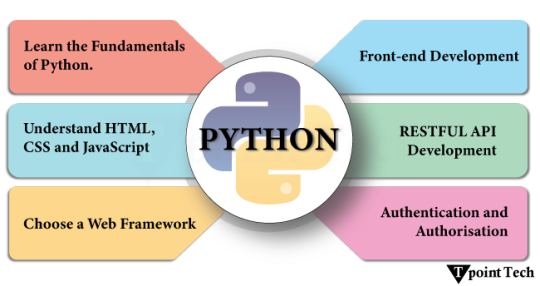
Embarking on the journey to master Python programming involves a structured roadmap to guide your learning process.
Learn the Basics
Data Structures and Algorithms
Functions and Modules
File Handling
1 note
·
View note
Text
The Next Wave: Exploring AI and Machine Learning Roadmap in 2024

What is AI and Machine Learning?
Artificial Intelligence (AI):
AI is a broad area of computer science that focuses on creating systems or machines capable of performing tasks that typically require human intelligence. These tasks include problem-solving, learning, perception, understanding natural language, and even decision-making. AI can be categorized into two types:
Narrow or Weak AI: This type of AI is designed to perform a specific task, such as speech recognition or image classification. It operates within a limited domain and doesn't possess generalized intelligence.
General or Strong AI: This is the hypothetical idea of AI possessing the ability to understand, learn, and apply knowledge across various domains, similar to human intelligence. Strong AI, however, is more a concept than a current reality.
Machine Learning (ML):
ML is a subset of AI that focuses on developing algorithms and statistical models that enable computers to perform a task without explicit programming. Instead of being explicitly programmed to perform a task, a machine learning system learns from data and improves its performance over time. ML can be categorized into three main types:
Supervised Learning: The model is trained on a labeled dataset, where the algorithm is provided with input-output pairs. It learns to map inputs to outputs, allowing it to make predictions or classifications on new, unseen data.
Unsupervised Learning: The model is given unlabeled data and is tasked with finding patterns or structures within it. Clustering and dimensionality reduction are common applications of unsupervised learning.
Reinforcement Learning: The algorithm learns by interacting with an environment. It receives feedback in the form of rewards or penalties, allowing it to learn optimal strategies for decision-making.
Edge of AI Machine Learning Roadmap
We stand at the threshold of 2024, and the landscape of Artificial Intelligence (AI) and Machine Learning (ML) unfurls a roadmap teeming with possibilities and innovation. This blog endeavors to elucidate the key trends, advancements, and transformative shifts that mark the AI and ML journey in the year 2024.
Continued Advancements in Deep Learning:
The year 2024 sees Deep Learning, a vanguard in ML, continuing its relentless march forward. Expect breakthroughs in neural network architectures, optimization algorithms, and training techniques, propelling the boundaries of what's achievable in AI applications.
AI for Edge Computing and Federated Learning:
Edge AI and Federated Learning take center stage as the paradigm shifts toward decentralized computing. In 2024, we witness a surge in the development of AI models capable of operating on edge devices, fostering real-time processing, and reducing reliance on centralized cloud servers.
Explainable AI (XAI) Reaches Maturity:
Explainability becomes a paramount concern in AI systems. In 2024, Explainable AI (XAI) matures, providing a clearer lens into the decision-making processes of complex algorithms. This transparency is crucial, especially in fields like healthcare, finance, and autonomous systems.
AI Ethics Takes Center Stage:
The ethical dimensions of AI gain prominence. With increasing societal reliance on AI, 2024 emphasizes the need for responsible AI development. Stricter ethical guidelines, frameworks, and regulations come into play to ensure fairness, transparency, and accountability in AI applications.
AI in Healthcare Revolutionized:
The intersection of AI and healthcare will witness a revolution in 2024. Advanced diagnostic tools, personalized medicine, and predictive analytics powered by machine learning algorithms redefine patient care. AI has become an indispensable ally in the quest for improved healthcare outcomes.
Quantum Computing Impact on ML:
The emergence of quantum computing leaves an indelible mark on ML. In 2024, we witness the exploration of quantum algorithms for machine learning tasks, promising exponential speedups in solving complex problems that were once computationally intractable.
AI Democratization and Accessibility:
The democratization of AI tools and technologies reaches new heights. In 2024, user-friendly platforms, open-source frameworks, and simplified interfaces empower a broader demographic to harness the capabilities of AI and ML, fostering innovation across diverse domains.
AI-powered Cybersecurity:
As cyber threats become more sophisticated, AI steps up as a formidable ally in cybersecurity. Machine learning models in 2024 demonstrate enhanced capabilities in detecting and thwarting cyberattacks, fortifying digital landscapes against evolving threats.
Hybrid Models and Interdisciplinary Collaboration:
The synergy between AI, ML, and other disciplines gains traction. In 2024, hybrid models that amalgamate different AI approaches find applications in diverse fields. Interdisciplinary collaboration becomes the norm, as AI professionals work alongside experts in various domains to solve complex problems.
Continuous Learning and Skill Evolution:
The pace of innovation in AI demands a commitment to continuous learning. In 2024, professionals in the field prioritize ongoing skill development, staying abreast of the latest advancements, and engaging in collaborative communities to foster a culture of knowledge exchange.
Conclusion:
The AI and Machine Learning roadmap for 2024 is a journey marked by innovation, ethical considerations, and the democratization of technology. As we navigate this dynamic landscape, the convergence of technological advancements and societal responsibility will define the narrative of progress. Whether in healthcare, cybersecurity, or interdisciplinary collaboration, the year 2024 unfolds a tapestry of possibilities, inviting professionals and enthusiasts alike to contribute to the ongoing evolution of AI and ML, shaping a future where intelligent systems coalesce seamlessly with the aspirations of a rapidly advancing world.
#machine learning#artificial intelligence#ai#technology#computer science#science#deep science#techinnovation#tech industry#technically#programming#software development#deep learning#datascience#data analytics#python#roadmap#future#futuristic#2024
0 notes
Text
Online Python Tutorial for Beginners in India
Learn the skills and techniques needed to become a successful Python Full Stack Developer with Simplealgo.com. Our comprehensive roadmap will help you develop the expertise you need to advance your career.
Python Full Stack Developer Roadmap
0 notes
Text
🚀 The best and ultimate frontend roadmap in 2023
Check out the link below:
#coding#developer#javascript#coder#python#roadmap#frontend development#software#software development#software engineering#viral
1 note
·
View note
Note
hi!! do you have any free resources or textbooks for learning python? i’m doing my dissertation and i need a refresher before i start doing it properly. thanks!!
Hiya! 💗
Here you go:
Book
Python Objects and Classes
Roadmap.sh
Random Python Resources
Top 20 Python Projects for Beginners to Master the Language
Free Programming Books
Python Notes and Resources by @trialn1error
Python Official Roadmap
Python Project List
Python 3 Cheat Sheet
Python Cheatsheet for Beginners
These are the ones' I've shared on my blog over the years! Hope their helpful! 🥰👍🏾💗
#my asks#resources#python resources#codeblr#coding#progblr#programming#studying#studyblr#learn to code#comp sci#tech#programmer
346 notes
·
View notes
Text
November 2nd

Journaling my to-do lists has made me see exactly what work I'm putting off and understand why I'm reluctant to do it. I'm pushing off every Python course when I get to APIs, and part of it just gets so much bigger at that point. When I struggle, I go back to the beginning instead of listening to my own needs. Spending the day at a coffee shop + some podcasts while I study and get back up. To-Do List: 🪶Set out a Python roadmap 🪶3 leet code questions 🪶Find a course specifically for Python APIs 🪶Develop a monthly budget 🪶Python Slot Machine Project 🪶Python course 4.5 🪶Finally get down to the Python exam 🪶Print out photos to scrapbook
What I got done:
🎀Made a Python roadmap 🎀2 leet code questions 🎀Found a promising API course 🎀Made a monthly budget 🎀Made about 1/3rd of the Python slot machine 🎀Python course 4.5
#study motivation#coffee#daily journal#study blog#studyblr#studyspo#to do list#python#coding#study aesthetic#motivation#dark academia#light academia
15 notes
·
View notes
Text
instagram
Hey there! 🚀 Becoming a data analyst is an awesome journey! Here’s a roadmap for you:
1. Start with the Basics 📚:
- Dive into the basics of data analysis and statistics. 📊
- Platforms like Learnbay (Data Analytics Certification Program For Non-Tech Professionals), Edx, and Intellipaat offer fantastic courses. Check them out! 🎓
2. Master Excel 📈:
- Excel is your best friend! Learn to crunch numbers and create killer spreadsheets. 📊🔢
3. Get Hands-on with Tools 🛠️:
- Familiarize yourself with data analysis tools like SQL, Python, and R. Pluralsight has some great courses to level up your skills! 🐍📊
4. Data Visualization 📊:
- Learn to tell a story with your data. Tools like Tableau and Power BI can be game-changers! 📈📉
5. Build a Solid Foundation 🏗️:
- Understand databases, data cleaning, and data wrangling. It’s the backbone of effective analysis! 💪🔍
6. Machine Learning Basics 🤖:
- Get a taste of machine learning concepts. It’s not mandatory but can be a huge plus! 🤓🤖
7. Projects, Projects, Projects! 🚀:
- Apply your skills to real-world projects. It’s the best way to learn and showcase your abilities! 🌐💻
8. Networking is Key 👥:
- Connect with fellow data enthusiasts on LinkedIn, attend meetups, and join relevant communities. Networking opens doors! 🌐👋
9. Certifications 📜:
- Consider getting certified. It adds credibility to your profile. 🎓💼
10. Stay Updated 🔄:
- The data world evolves fast. Keep learning and stay up-to-date with the latest trends and technologies. 📆🚀
. . .
#programming#programmers#developers#mobiledeveloper#softwaredeveloper#devlife#coding.#setup#icelatte#iceamericano#data analyst road map#data scientist#data#big data#data engineer#data management#machinelearning#technology#data analytics#Instagram
8 notes
·
View notes
Text
How to Become a Data Scientist in 2025 (Roadmap for Absolute Beginners)

Want to become a data scientist in 2025 but don’t know where to start? You’re not alone. With job roles, tech stacks, and buzzwords changing rapidly, it’s easy to feel lost.
But here’s the good news: you don’t need a PhD or years of coding experience to get started. You just need the right roadmap.
Let’s break down the beginner-friendly path to becoming a data scientist in 2025.
✈️ Step 1: Get Comfortable with Python
Python is the most beginner-friendly programming language in data science.
What to learn:
Variables, loops, functions
Libraries like NumPy, Pandas, and Matplotlib
Why: It’s the backbone of everything you’ll do in data analysis and machine learning.
🔢 Step 2: Learn Basic Math & Stats
You don’t need to be a math genius. But you do need to understand:
Descriptive statistics
Probability
Linear algebra basics
Hypothesis testing
These concepts help you interpret data and build reliable models.
📊 Step 3: Master Data Handling
You’ll spend 70% of your time cleaning and preparing data.
Skills to focus on:
Working with CSV/Excel files
Cleaning missing data
Data transformation with Pandas
Visualizing data with Seaborn/Matplotlib
This is the “real work” most data scientists do daily.
🧬 Step 4: Learn Machine Learning (ML)
Once you’re solid with data handling, dive into ML.
Start with:
Supervised learning (Linear Regression, Decision Trees, KNN)
Unsupervised learning (Clustering)
Model evaluation metrics (accuracy, recall, precision)
Toolkits: Scikit-learn, XGBoost
🚀 Step 5: Work on Real Projects
Projects are what make your resume pop.
Try solving:
Customer churn
Sales forecasting
Sentiment analysis
Fraud detection
Pro tip: Document everything on GitHub and write blogs about your process.
✏️ Step 6: Learn SQL and Databases
Data lives in databases. Knowing how to query it with SQL is a must-have skill.
Focus on:
SELECT, JOIN, GROUP BY
Creating and updating tables
Writing nested queries
🌍 Step 7: Understand the Business Side
Data science isn’t just tech. You need to translate insights into decisions.
Learn to:
Tell stories with data (data storytelling)
Build dashboards with tools like Power BI or Tableau
Align your analysis with business goals
🎥 Want a Structured Way to Learn All This?
Instead of guessing what to learn next, check out Intellipaat’s full Data Science course on YouTube. It covers Python, ML, real projects, and everything you need to build job-ready skills.
https://www.youtube.com/watch?v=rxNDw68XcE4
🔄 Final Thoughts
Becoming a data scientist in 2025 is 100% possible — even for beginners. All you need is consistency, a good learning path, and a little curiosity.
Start simple. Build as you go. And let your projects speak louder than your resume.
Drop a comment if you’re starting your journey. And don’t forget to check out the free Intellipaat course to speed up your progress!
2 notes
·
View notes
Text
How to Transition from Biotechnology to Bioinformatics: A Step-by-Step Guide

Biotechnology and bioinformatics are closely linked fields, but shifting from a wet lab environment to a computational approach requires strategic planning. Whether you are a student or a professional looking to make the transition, this guide will provide a step-by-step roadmap to help you navigate the shift from biotechnology to bioinformatics.
Why Transition from Biotechnology to Bioinformatics?
Bioinformatics is revolutionizing life sciences by integrating biological data with computational tools to uncover insights in genomics, proteomics, and drug discovery. The field offers diverse career opportunities in research, pharmaceuticals, healthcare, and AI-driven biological data analysis.
If you are skilled in laboratory techniques but wish to expand your expertise into data-driven biological research, bioinformatics is a rewarding career choice.
Step-by-Step Guide to Transition from Biotechnology to Bioinformatics
Step 1: Understand the Basics of Bioinformatics
Before making the switch, it’s crucial to gain a foundational understanding of bioinformatics. Here are key areas to explore:
Biological Databases – Learn about major databases like GenBank, UniProt, and Ensembl.
Genomics and Proteomics – Understand how computational methods analyze genes and proteins.
Sequence Analysis – Familiarize yourself with tools like BLAST, Clustal Omega, and FASTA.
🔹 Recommended Resources:
Online courses on Coursera, edX, or Khan Academy
Books like Bioinformatics for Dummies or Understanding Bioinformatics
Websites like NCBI, EMBL-EBI, and Expasy
Step 2: Develop Computational and Programming Skills
Bioinformatics heavily relies on coding and data analysis. You should start learning:
Python – Widely used in bioinformatics for data manipulation and analysis.
R – Great for statistical computing and visualization in genomics.
Linux/Unix – Basic command-line skills are essential for working with large datasets.
SQL – Useful for querying biological databases.
🔹 Recommended Online Courses:
Python for Bioinformatics (Udemy, DataCamp)
R for Genomics (HarvardX)
Linux Command Line Basics (Codecademy)
Step 3: Learn Bioinformatics Tools and Software
To become proficient in bioinformatics, you should practice using industry-standard tools:
Bioconductor – R-based tool for genomic data analysis.
Biopython – A powerful Python library for handling biological data.
GROMACS – Molecular dynamics simulation tool.
Rosetta – Protein modeling software.
🔹 How to Learn?
Join open-source projects on GitHub
Take part in hackathons or bioinformatics challenges on Kaggle
Explore free platforms like Galaxy Project for hands-on experience
Step 4: Work on Bioinformatics Projects
Practical experience is key. Start working on small projects such as:
✅ Analyzing gene sequences from NCBI databases ✅ Predicting protein structures using AlphaFold ✅ Visualizing genomic variations using R and Python
You can find datasets on:
NCBI GEO
1000 Genomes Project
TCGA (The Cancer Genome Atlas)
Create a GitHub portfolio to showcase your bioinformatics projects, as employers value practical work over theoretical knowledge.
Step 5: Gain Hands-on Experience with Internships
Many organizations and research institutes offer bioinformatics internships. Check opportunities at:
NCBI, EMBL-EBI, NIH (government research institutes)
Biotech and pharma companies (Roche, Pfizer, Illumina)
Academic research labs (Look for university-funded projects)
💡 Pro Tip: Join online bioinformatics communities like Biostars, Reddit r/bioinformatics, and SEQanswers to network and find opportunities.
Step 6: Earn a Certification or Higher Education
If you want to strengthen your credentials, consider:
🎓 Bioinformatics Certifications:
Coursera – Genomic Data Science (Johns Hopkins University)
edX – Bioinformatics MicroMasters (UMGC)
EMBO – Bioinformatics training courses
🎓 Master’s in Bioinformatics (optional but beneficial)
Top universities include Harvard, Stanford, ETH Zurich, University of Toronto
Step 7: Apply for Bioinformatics Jobs
Once you have gained enough skills and experience, start applying for bioinformatics roles such as:
Bioinformatics Analyst
Computational Biologist
Genomics Data Scientist
Machine Learning Scientist (Biotech)
💡 Where to Find Jobs?
LinkedIn, Indeed, Glassdoor
Biotech job boards (BioSpace, Science Careers)
Company career pages (Illumina, Thermo Fisher)
Final Thoughts
Transitioning from biotechnology to bioinformatics requires effort, but with the right skills and dedication, it is entirely achievable. Start with fundamental knowledge, build computational skills, and work on projects to gain practical experience.
Are you ready to make the switch? 🚀 Start today by exploring free online courses and practicing with real-world datasets!
#bioinformatics#biopractify#biotechcareers#biotechnology#biotech#aiinbiotech#machinelearning#bioinformaticstools#datascience#genomics#Biotechnology
4 notes
·
View notes
Text

January 6th, 2024
Absolutely exhausting day at a new client office today, but I started the day coding at a new coffee shop and did some studying before heading back.
I set out a roadmap for 2 possible careers I want/could go into- software architecture vs. business/data analysis. I made a long term (kinda?) career plan for both, including skills to learn + study resources
Attended several meetings and went through some learning resources for project management
Continued coding Python, continuing with a Python Django project I started
Playlist for the day:
Tomorrow I'd like to proceed with looking at my long-term road map planning for the week's work studying some new topics I'll need at work and continue with a ton of coding practice. I'll probably be too tired to wake up though.
#academic assignments#academic burnout#academia aesthetic#academic victim#academic romance#academic disaster#study aesthetic#academic validation#study hard#study blog#workblr#codeblr#studyblr#chaotic academia#dark academic aesthetic#desi academia#code#python#Spotify
6 notes
·
View notes
Text
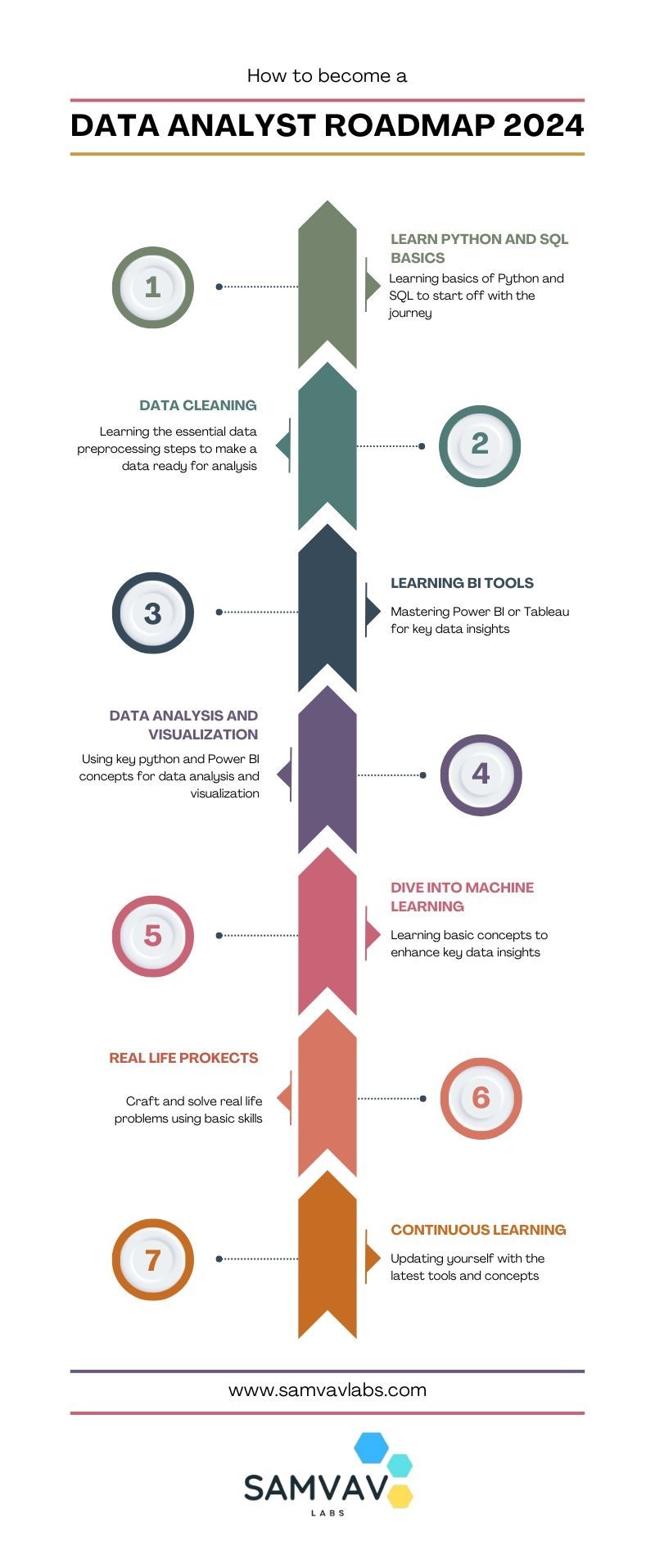
Data Analyst Roadmap for 2024!
Cracking the Data Analyst Roadmap for 2024! Kick off your journey by mastering and delving into Python for data manipulation magic, and dazzle stakeholders with insights using PowerBi or Tableau. Don't forget, that SQL proficiency and hands-on projects refine your skillset, but never overlook the importance of effective communication and problem-solving. Are you checking off these milestones on your path to success? 📌 For more details, visit our website: https://www.samvavlabs.com . . . #DataAnalyst2024 #CareerGrowth #roadmap #DataAnalyst #samvavlabs #roadmap2024 #dataanalystroadmap #datavisualization
#business analytics#data analytics#data analyst#machinelearning#data visualization#datascience#deep learning#data analyst training#dataanalystcourseinKolkata#data analyst certification#data analyst course#data science course#business analyst
12 notes
·
View notes
Text
“By hanging on to outdated imperialist dogma which perpetuates the economic and social differences in our society.” – Monty Python and the Holy Grail

Smoking will give you diseases, but it cures salmon.
The GloboLeftElite have long been planning the takeover of the United States. It’s obvious that this is the case because their thinkers have been plotting the roadmap since, well, forever. Antonio Gramsci was one such leader, and here’s a quote from him:
“Socialism is precisely the religion that must overwhelm Christianity. … In the new order, socialism will triumph by first capturing the culture via infiltration of schools, universities, churches, and the media by transforming the consciousness of society.”
Gramsci may have been a (really) sub-60-inch-tall Albanian cripple who was in constant pain, born to a criminal father, but let’s let bygones be bygones. This is nearly exactly what the GloboLeftElite did. Their scholars left Europe ahead of certain German extended continental excursions in the 1930s, and many of them made their home in the United States.
Note, they didn’t all go to the socialist paradise of the Union of Soviet Socialist Republics. Nope. The Soviets were too busy starving themselves, executing each other, and building GULAGs for fun and profit.
Instead, these “Socialists” wanted to come to a functional society that was producing wealth and wreck it. Gramsci didn’t join them, because he died. Based on the list of things that Antonio was suffering from at the time – spinal deformity, arteriosclerosis, pulmonary tuberculosis, high blood pressure, angina, gout, and acute gastric disorders – if he was a dog his name would have been “Lucky”.
The functional society that they wanted to wreck? The United States.
2 notes
·
View notes
Text
The Roadmap to Full Stack Developer Proficiency: A Comprehensive Guide
Embarking on the journey to becoming a full stack developer is an exhilarating endeavor filled with growth and challenges. Whether you're taking your first steps or seeking to elevate your skills, understanding the path ahead is crucial. In this detailed roadmap, we'll outline the stages of mastering full stack development, exploring essential milestones, competencies, and strategies to guide you through this enriching career journey.

Beginning the Journey: Novice Phase (0-6 Months)
As a novice, you're entering the realm of programming with a fresh perspective and eagerness to learn. This initial phase sets the groundwork for your progression as a full stack developer.
Grasping Programming Fundamentals:
Your journey commences with grasping the foundational elements of programming languages like HTML, CSS, and JavaScript. These are the cornerstone of web development and are essential for crafting dynamic and interactive web applications.
Familiarizing with Basic Data Structures and Algorithms:
To develop proficiency in programming, understanding fundamental data structures such as arrays, objects, and linked lists, along with algorithms like sorting and searching, is imperative. These concepts form the backbone of problem-solving in software development.
Exploring Essential Web Development Concepts:
During this phase, you'll delve into crucial web development concepts like client-server architecture, HTTP protocol, and the Document Object Model (DOM). Acquiring insights into the underlying mechanisms of web applications lays a strong foundation for tackling more intricate projects.
Advancing Forward: Intermediate Stage (6 Months - 2 Years)
As you progress beyond the basics, you'll transition into the intermediate stage, where you'll deepen your understanding and skills across various facets of full stack development.
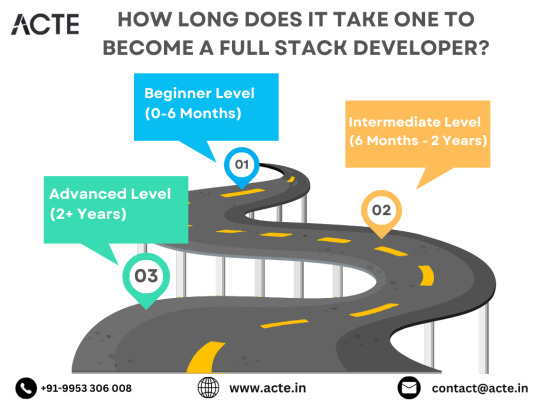
Venturing into Backend Development:
In the intermediate stage, you'll venture into backend development, honing your proficiency in server-side languages like Node.js, Python, or Java. Here, you'll learn to construct robust server-side applications, manage data storage and retrieval, and implement authentication and authorization mechanisms.
Mastering Database Management:
A pivotal aspect of backend development is comprehending databases. You'll delve into relational databases like MySQL and PostgreSQL, as well as NoSQL databases like MongoDB. Proficiency in database management systems and design principles enables the creation of scalable and efficient applications.
Exploring Frontend Frameworks and Libraries:
In addition to backend development, you'll deepen your expertise in frontend technologies. You'll explore prominent frameworks and libraries such as React, Angular, or Vue.js, streamlining the creation of interactive and responsive user interfaces.
Learning Version Control with Git:
Version control is indispensable for collaborative software development. During this phase, you'll familiarize yourself with Git, a distributed version control system, to manage your codebase, track changes, and collaborate effectively with fellow developers.
Achieving Mastery: Advanced Phase (2+ Years)
As you ascend in your journey, you'll enter the advanced phase of full stack development, where you'll refine your skills, tackle intricate challenges, and delve into specialized domains of interest.
Designing Scalable Systems:
In the advanced stage, focus shifts to designing scalable systems capable of managing substantial volumes of traffic and data. You'll explore design patterns, scalability methodologies, and cloud computing platforms like AWS, Azure, or Google Cloud.
Embracing DevOps Practices:
DevOps practices play a pivotal role in contemporary software development. You'll delve into continuous integration and continuous deployment (CI/CD) pipelines, infrastructure as code (IaC), and containerization technologies such as Docker and Kubernetes.
Specializing in Niche Areas:
With experience, you may opt to specialize in specific domains of full stack development, whether it's frontend or backend development, mobile app development, or DevOps. Specialization enables you to deepen your expertise and pursue career avenues aligned with your passions and strengths.
Conclusion:
Becoming a proficient full stack developer is a transformative journey that demands dedication, resilience, and perpetual learning. By following the roadmap outlined in this guide and maintaining a curious and adaptable mindset, you'll navigate the complexities and opportunities inherent in the realm of full stack development. Remember, mastery isn't merely about acquiring technical skills but also about fostering collaboration, embracing innovation, and contributing meaningfully to the ever-evolving landscape of technology.
#full stack developer#education#information#full stack web development#front end development#frameworks#web development#backend#full stack developer course#technology
10 notes
·
View notes
Text
How to Become a Cloud Computing Engineer
Introduction:
Cloud computing has become a cornerstone of modern IT infrastructure, making the role of a Cloud Computing Engineer highly in demand. If you're looking to enter this field, here's a roadmap to help you get started:
Build a Strong Foundation in IT A solid understanding of computer networks, operating systems, and basic programming is essential. Consider getting a degree in Computer Science or Information Technology. Alternatively, Jetking offer you to make your career in Cloud computing Courses and gain the technical knowledge needed.
Learn Cloud Platforms Familiarize yourself with popular cloud service providers such as AWS (Amazon Web Services), Microsoft Azure, and Google Cloud. Many platforms offer certification courses, like AWS Certified Solutions Architect, which will help validate your skills.
Gain Hands-On Experience Practical experience is critical. Set up your own cloud projects, manage databases, configure servers, and practice deploying applications. This will give you the real-world experience that employers seek.
Master Programming Languages Learn programming languages commonly used in cloud environments, such as Python, Java, or Ruby. Scripting helps automate tasks, making your work as a cloud engineer more efficient.
Understand Security in the Cloud Security is paramount in cloud computing. Gain knowledge of cloud security best practices, such as encryption, data protection, and compliance standards to ensure safe operations and become Master in cloud computing courses.
Get Certified Earning cloud certifications from AWS, Azure, or Google Cloud can enhance your credibility. Certifications like AWS Certified Cloud Practitioner or Microsoft Certified: Azure Fundamentals can provide you a competitive edge.
Keep Learning Cloud technology evolves rapidly, so continuous learning is key. Stay updated by taking advanced courses and attending cloud tech conferences.
Join Jetking today! Click Here
By building your expertise in these areas, you’ll be well on your way to a successful career as a Cloud Computing Engineer!
2 notes
·
View notes
Text
Lua x Electronics
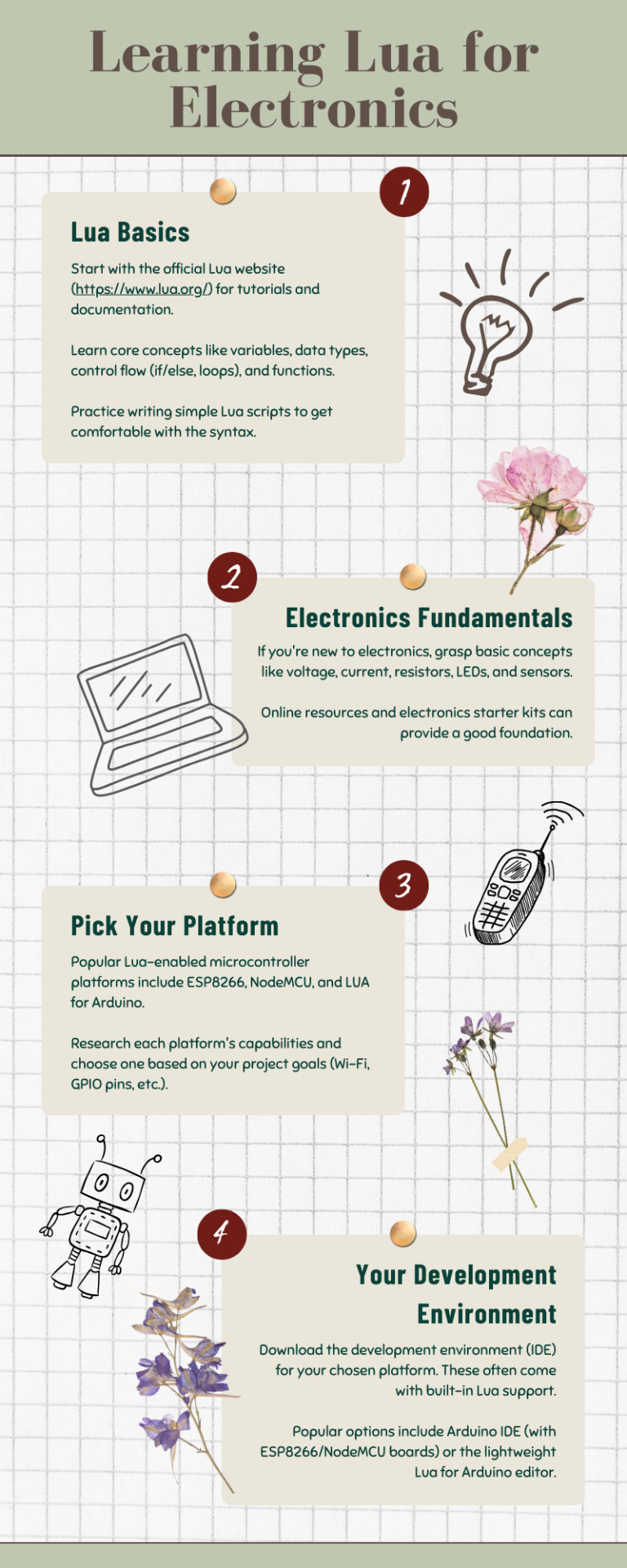
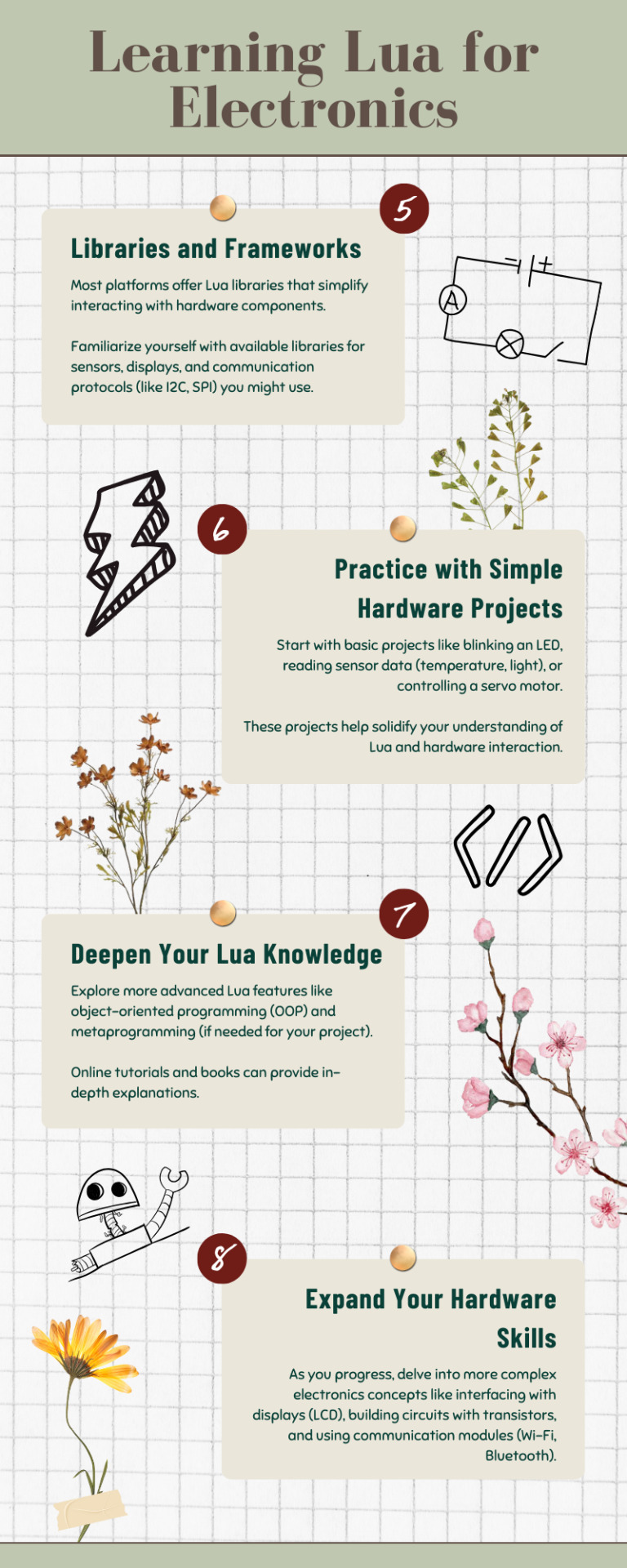
: ̗̀➛ Lua is a beginner-friendly scripting language that is well-suited for individuals starting out in Electronics. A simple roadmap to learning it for electronics projects! It'll break down the learning process into clear steps!
Due to its lightweight and efficient nature, Lua is perfect for microcontrollers (tiny computers in electronics) with restricted resources. This language enables users to engage with sensors and manage electronic components such as LEDs and motors in various projects.

!! There are other more popular programming languages for getting into Electronics such as C, C++ and Python! I'm just promoting Lua because it's still a good language to start with~!
#my resources#coding#codeblr#programming#progblr#studyblr#studying#comp sci#computer science#robotics#electronics#lua#tech#studyblr community#cs academia#programmer#study tips
116 notes
·
View notes